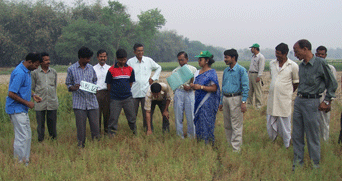|
April, 2009
Source:
CGIAR
newsletter, April 2009
Lentil — also called pulse or daal — attracts attention in India
with its potential to alleviate micronutrient deficiency and
promise of higher, more stable yields
 Lentil
genotypes identified at the
International Center for Agricultural Research in the Dry Areas
(ICARDA) and further developed by the Indian Institute of Pulses
Research (IIPR) could help rescue millions from the “hidden
hunger“ of micronutrient malnutrition. Meanwhile, a new lentil
cultivar is replacing short fallows in India with valuable
harvests. Lentil
genotypes identified at the
International Center for Agricultural Research in the Dry Areas
(ICARDA) and further developed by the Indian Institute of Pulses
Research (IIPR) could help rescue millions from the “hidden
hunger“ of micronutrient malnutrition. Meanwhile, a new lentil
cultivar is replacing short fallows in India with valuable
harvests.
More than half the world’s population suffers micronutrient
deficiency. Among the worst affected are women and young
children. Anemia, caused by iron deficiency, is common among
Indian women, and a significant portion of Indian children under
5, especially those in poor households, suffer stunted growth.
One possible answer is biofortification to develop
micronutrient-rich varieties of staple crops. The CGIAR’s
HarvestPlus Challenge Program focuses on three micronutrients —
iron, zinc and vitamin A — that are generally deficient in the
diets of poor households across South Asia. A key participant in
HarvestPlus, ICARDA focuses on lentils, a major staple in the
region. Lentil germplasm, breeding lines and cultivars with high
iron and zinc content have been identified and constituted into
nurseries that are distributed to national breeding programs for
testing and development.
IIPR scientists grew the nursery at their research farm during
the 2007/08 crop season and analyzed harvested samples using an
atomic absorption spectrophotometer. Shiv Kumar, head of IIPR’s
Crop Improvement Division, reports that the lines in the ICARDA
nursery hugely outperformed local materials. The nursery lines
had zinc levels ranging from 27 to 66 milligrams per kilogram
(mg/kg), with a mean of 47 mg/kg, compared with 3.8-15.6 mg/kg
(mean 8.4) in local genotypes. For iron content, the nursery
lines had levels of 34-109 mg/kg (mean 49), compared with 28-77
mg/kg (mean 37) in local genotypes.
Six genotypes had unusually high zinc content, greater than 50
mg/kg. Eight genotypes had iron content above 50 mg/kg. Three
genotypes were notably rich in both zinc and iron. All but one
of these lines richest in zinc and/or iron were developed at
ICARDA. They promise to become building blocks for new,
micronutrient-rich lentil varieties. An IIPR team will test them
further for micronutrient content and stability, as well as
agronomic and phenological traits.
Meanwhile, a new lentil variety developed by the Indian national
program from material supplied by ICARDA has been released for
cultivation. Called Moitree, meaning “friendship,” the new
variety is a major breakthrough for two reasons. First, it
resists rust and Stemphylium blight, which have forced farmers
in northeast India to all but abandon lentil cultivation.
Second, it can be planted a month later than normal without
significant yield loss. This makes it ideal for the relatively
short period following the rice harvest, when fields are usually
left fallow. The potential area in India for this use is 11
million hectares.
Lentils are important in India and elsewhere in South Asia
because they are a major source of protein for millions of poor
households. More lentils mean better nutrition and perhaps lower
prices.
Moitree is a truly international variety. It was developed
through single-plant selection by Indian breeders from a
segregating population developed at ICARDA in Syria by crossing
a Pakistani landrace with a Bangladeshi breeding line. The aim
was to breed new varieties for specific short-season
environments. Third-generation progenies from the cross were
distributed to national research centers in Bangladesh,
Ethiopia, India and Nepal. Indian scientists at the Pulses and
Oilseeds Research Station at Berhampore, West Bengal, then took
the process forward.
In 2002, the new line started undergoing several seasons of
on-station and on-farm testing to evaluate yield, disease
resistance and agronomic traits. In on-station trials, it
yielded half again more than existing cultivars. On farmers’
fields, it outyielded check varieties by between 34% and 57%,
producing an average yield of 1,150 kg per hectare, or nearly
40% more than the 830 kg of the highest-yielding check variety.
Moitree has wide adaptation and has been recommended for
cultivation in West Bengal, Assam, Bihar and Jharkhand. Limited
quantities of seed have been distributed to farmers over the
past few years, and feedback has been excellent.
“Moitree is a blessing,” said one farmer who plans to double his
lentil area next year. “For the first time, we can get steady
yields from lentil.”
The variety is being scaled out through demonstrations on
farmers’ fields across West Bengal. Over 100 farmers have
received seed since the variety’s release, and ICARDA’s partners
in India expect adoption to expand rapidly. |
|